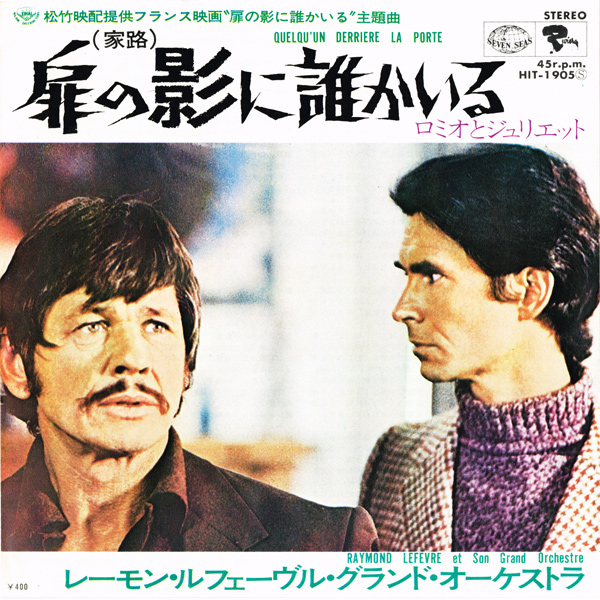45 R.P.M.: QUELQU'UN DERRIERE LA PORTE

HIT-1905 S, Seven Seas, King Record Co. Ltd., Japan. P '71-8. Recorded by Riviera (France).
- Quelqu'un Derriere la Porte (Largo de Dvorak de la Symphonie du Nouveau Monde) (3:02) (Arreg. R. Lefebvre)
- Un Jour pour Nous (2:44) Theme from Romeo and Juliet (N. Rota)
SLEEVE NOTES:
The French film "Quelqu'un Derriere la Porte," which had been talked about even before its completion, featuring Charles Bronson and Anthony Perkins, has arrived. This record features the Raymond Lefebvre Orchestra of "White Roses" fame performing its theme music, namely the famous melody from "From the New World" composed by Dvoráák.
A close-up of a round head with black lines and Anthony Perkins holding a scalpel appears. There is no music, only the eerie, regular sound of a heartbeat. The suspense begins with a breathtaking scene in which the sharp tip of the scalpel threatens to enter the scalpel. Charles Bronson, as the mysterious man, appears a short time later. His encounter with Perkins and the conversation between the two men piques great interest in what storyline is about to unfold. From Saturday night to Monday morning, the perfect crime will be committed, how it will be carried out, and what the outcome will be...
The film is directed by Nicholas Gessener, who also directed "Un milliard dans un billard" and "La Blonde de Pékin," and features music by Georges Garvarentz of "Sappho," with an arrangement of "Homeward" from "From the New World."
There are many other examples of classical music being used in film packs besides those that tell a composer's story, such as "Tchaikovsky" and "Song of Norway. Among them, "Elvira Madigan" is the most famous, followed by "The Wild Child," "The Green Wall," "La Maison de Bories," "The Bear and The Doll," and "Quelqu'un derrière la porte," and this autumn's hot film, "Death in Venice," directed by Luchino Visconti, which is currently a big hit in London, features Gustav Mahler's 3rd and 5th symphonies are used in the film.
About Raymond Lefevbre
Influenced by his violin-playing father, Lefebvre began his musical career as a classical flutist, but switched to popular music while playing piano part-time in clubs and dance halls. In 1956, Lefebvre created his own combo, and that year he was recognized by Dalida, then a newcomer, when he accompanied her on her first big hit, "Bambino" (Little Boy). In 1968, "Âme Câline" became a big hit in the U.S. and brought him international fame. In Japan, she is known for her hits "The Queen of Sheba," "Canon," and most recently "Lady D'Arbanville." In films, he has composed the music for the so-called "Gendarme" (Military Police) series, including the recent "Le Gendarme en Balade". There is also talk of the Raymond Lefebvre Orchestra coming to Japan soon, so keep your eyes peeled for them.
Quelqu'un Derriere la Porte:
In the film, the song is heard for the first time when Perkins plays the record at home, and as Bronson, dismayed, looks around the room, the record comes back on and the song starts playing again.
The original is the Largo theme from the second movement of the symphony "From the New World" written by the Czechoslovakian composer Dvorák (1841-1904) in 1893 during his stay in the United States. Lefebvre's arrangement has a faster, more modern tempo, but the English horn theme in the original has been replaced by harmonica, restoring the melancholy of the plains that had nearly been lost at the faster tempo.
A Time For Us:
This hit song by the Henry Mancini Orchestra is the love theme from the 1968 Paramount film "Romeo and Juliet," directed by Franco Zeffirelli and starring Leonard Whiting and Olivia Hussey. In the scene where Romeo and Juliet meet for the first time at the Capulet family feast, Glen Weston sings "What is youth?" and Lefebvre plays the melody featuring piano with beautiful strings in the background.
The music was composed by Italian veteran Nino Rota, who is also well known for "La Strada" and "Plein Soleil."
About Georges Garvarentz
Georges Garvarentz was a Greek-born Armenian who had fled to France with his parents. He married Aida, the sister of Charles Aznavour, who was also Armenian and had parents in exile. He later entered the film industry on Aznavour's recommendation and had a number of hits, including "Douce Violence" and "Find the Idol." Other films include "Les Parisiennes," "Les Bonnes Causes," "La Fabuleuse Aventure de Marco Polo," "Triple Cross," "The Big Softie," "L'Amour," and "Sappho." There are also many chansons written by Charles Aznavour and composed by Garvarentz, among which "Le Cabotin" and "La Lumiere" are masterpieces, as well as beautiful songs such as "Et Pourtant" and "Paris au mois d'août" as movie theme songs. The new film by Garvarentz is a masterpiece.
Garvarentz's new film, "In the Blue Darkness," is scheduled to be released this year.
Shizuo Miyauchi, TBS
Recorded by RIVIERA, France
Note: Translation made by online translator.
